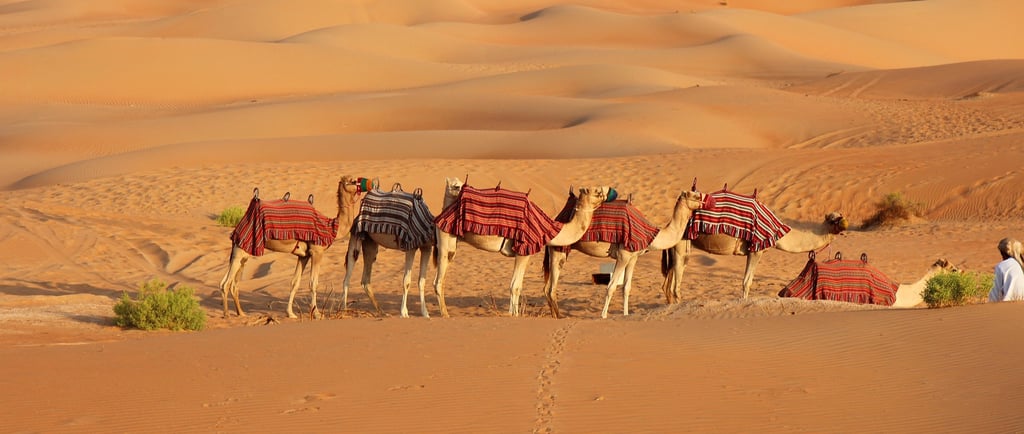🐪🚶 Walking with the Nomads - Following the Rhythm of the Land 🌾🕊️
🌍 A follow-up story that connects the Human Geography chapter in the Geography Album and Migrations in the History Album. 🐪🌿 It invites children to walk alongside the world’s first nomads—those who left fertile lands when the rains stopped and the soil cracked, becoming the Desert Walkers. As the land changed, so did human life: some became herders, some became traders, and others continued wandering with the rhythm of the Earth. 🌬️🏞️ This story makes visible the deep connection between climate, movement, and human adaptation—echoing migrations in ancient times and even today. It links beautifully with further studies of pastoral life, settlement patterns, and how humans live in harmony with challenging environments. It sparks wonder: 💭 “Where are people still walking today—not to explore, but because the land is changing beneath their feet?”
HISTORY STORIESGEOGRAPHY STORIES
6/25/20253 min read


Long ago, in what we now call North Africa, near the edge of the growing Sahara, a group of early people lived in a land of green valleys, running water, and wild grain. 🌾 They hunted gazelle, gathered fruit, and found shade beneath trees. They had what they needed—food, water and shelter . 🏞️
But then, the wind changed. 🌬️ The rains stopped coming. The rivers grew shallow. Slowly, the green land began to dry. Cracks formed in the soil. The grass turned gold, then grey. The animals disappeared into the hills. The people waited. And waited. But the rain did not return.
At first, they stayed. They dug deeper, saved what they could, and planted the seeds from their stores. But the seeds would not sprout. The hunters came back empty. It felt as though even the sky had moved on. So, the people made a choice: to move. 👣
They packed what they could carry: grinding stones, fire starters, a pouch of seeds, and stories from their elders. They followed what was left of the river, moving slowly toward a place where the grass was still green, the wild animals gathered, and the trees still gave shade. 🐾🌱
They became the desert walkers—the first of many who would leave a place not because they wanted to, but because the land could no longer meet their needs.
But this was not the end. Over time, others followed these same dry paths, learning how to live where rain rarely falls. Some became nomads—from the Greek nomas, meaning “wandering shepherd.” These were desert people who moved with the rhythm of the land. 🐄🌿 They herded goats or camels, slept beneath the stars, and followed ancient wells known only by memory and the shape of the hills. 🌾🐪
Others settled in greener places, planting new fields and remembering the dry land in songs and stories passed on to their children. Today, there are still nomads. Nomads live in many ways. Some are hunter-gatherers, moving with the seasons to find fruit, edible roots, or wild animals—what we call game, such as antelope, rabbits, or birds—for food. 🏹🍇Others are pastoral nomads, who live with and depend on their herds. Some are trader nomads, bringing goods from village to village, their wagons filled with tools, beads, or cloth. There are even semi-nomads, who build temporary homes and return to them each year like migrating birds.
This story is not just about long long ago.
🌌Today, the Tuareg people of the Sahara wrap indigo cloths around their heads and lead caravans across golden dunes, guided by starlight and memory.
☕The Bedouins of Arabia move their herds from spring pasture to winter camp, building tents from woven goat hair and sharing tea beneath the desert sun. ☕
🐐The Mongolian herders travel the dry edges of the Gobi Desert, living in round felt yurts and following their animals to water. 🐐
🎶 In Australia, Aboriginal peoples once moved from waterhole to waterhole guided not by maps, but by songlines—paths sung through the land, passed down like whispered directions from one generation to the next.
🧭 Even in the Arctic, the Sámi people of northern Europe follow their reindeer herds across the snowy tundra. They live in harmony with the harsh, icy land, wrapping themselves in warm furs, traveling by sled, and sometimes resting beneath the northern lights that dance across the sky. 🦌❄️🌌
Nomadism is not about being lost or wandering around —it’s about knowing deeply where to go next. It is the wisdom 🌟 of those who read the stars ✨, follow the rains 🌧️, and understand the land 🌾, not just live on it. It’s more than survival—it’s harmony 🌿. A way of living lightly 🏕️, taking only what is needed 🎒, and leaving space for the Earth to breathe, bloom 🌸, and rest 🌙.
💭 I wonder... What tools and traditions helped each group survive in their environment? Are there still Desert Walkers in the world? 🌍🤔
🔍 Follow-up Questions for Research 🌱💬
How do modern nomads live today—have their traditions changed or remained the same?
Are there places where nomadic life is disappearing or being preserved?
Are people today still migrating because of drought or climate change?
Look into the clothing, shelter (e.g., tents), and daily life of a specific nomadic group. What do they carry with them?
With Montessori joy,
Vanina 😊

